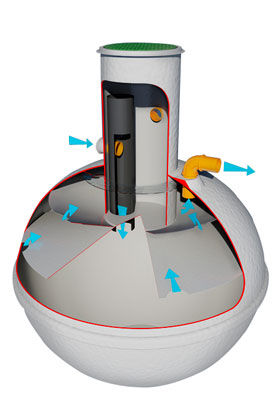What is the Difference between a Cesspit and a Septic Tank?
- Independent Drainage
- Jan 24, 2022
- 2 min read
Independent Drainage – the south coast’s experts in cesspits, septic tanks and sewage treatment plants.

The difference between a cesspit and a septic tank is that a cesspit is a single chamber that simply stores wastewater and offers no processing whatsoever – while a septic tank uses multiple chambers and offers basic sewage treatment processing. Read on to find out what that means for regulations and emptying procedures.
Septic Tanks
Septic tanks are very simple, but clever. They use natural bacteria to break down waste, in a multi-chambered process. Wastewater comes into the tank’s first chamber, where the majority of solids sink to the bottom – and bacteria then feed on the waste.
The process is repeated to a lesser extent in subsequent chambers, thereby processing the sewage, separating water from solids and removing environmental contaminants incrementally.
At this stage, water is still not processed enough to empty into a watercourse – and septic tanks require a drainage field as a final step.
Cesspits
With only a single chamber and no outflow, cesspits are even simpler still. Cesspits do not process waste at all, or allow water to drain into a drainage field. They’re completely sealed – and once waste goes in, it stays there until it’s time to empty the cesspit. This simplicity has advantages and disadvantages when compared to a septic tank.
Septic Tank VS. Cesspit
A septic tank facilitates an anaerobic process that offers basic sewage treatment – but the solids still have to be regularly emptied and, although the bacterial process is occurring, a septic tank isn’t self-maintaining. Emptying and maintenance are recommended at least annually. A septic tank installation also requires the installation of a drainage field – and these need space, as well as the right kind of ground for percolation to occur. You’ll need a permit to discharge this partially treated wastewater if more than 2,000 litres of it are produced a day, per day or if your property is in a groundwater source protection zone. You also need to be aware of the General Binding Rules. Cesspits, on the other hand, don’t require permits and can be installed anywhere. This can make them an attractive temporary solution for off-mains drainage and a compelling permanent solution – but they’re not perfect. Even though their initial cost is lower (due to their simplicity and relative ease of manufacture), they require frequent emptying – possibly more so than other systems, because they are single, sealed chambers. Problems can appear quickly, and regular maintenance is highly recommended to avoid overflow, bad smells and damage. Choosing between a cesspit and a septic tank will largely be dependent on where you live, the kind of ground you have and how much space is available for your off-mains sewage system. We can help guide you through the different off-mains sewage systems available, and find the right solution for you.
Looking for a septic tank specialist?
Problems with your cesspit? Looking for advice about your septic tank? Talk to Independent Drainage – our friendly, knowledgeable off-mains drainage advisors are ready to help. Call us now on 0800 0131301 or book a free consultation online.
Privacy Policy | Septic Tanks | Sewage Plants | Cesspit | Surveying | About




Comments